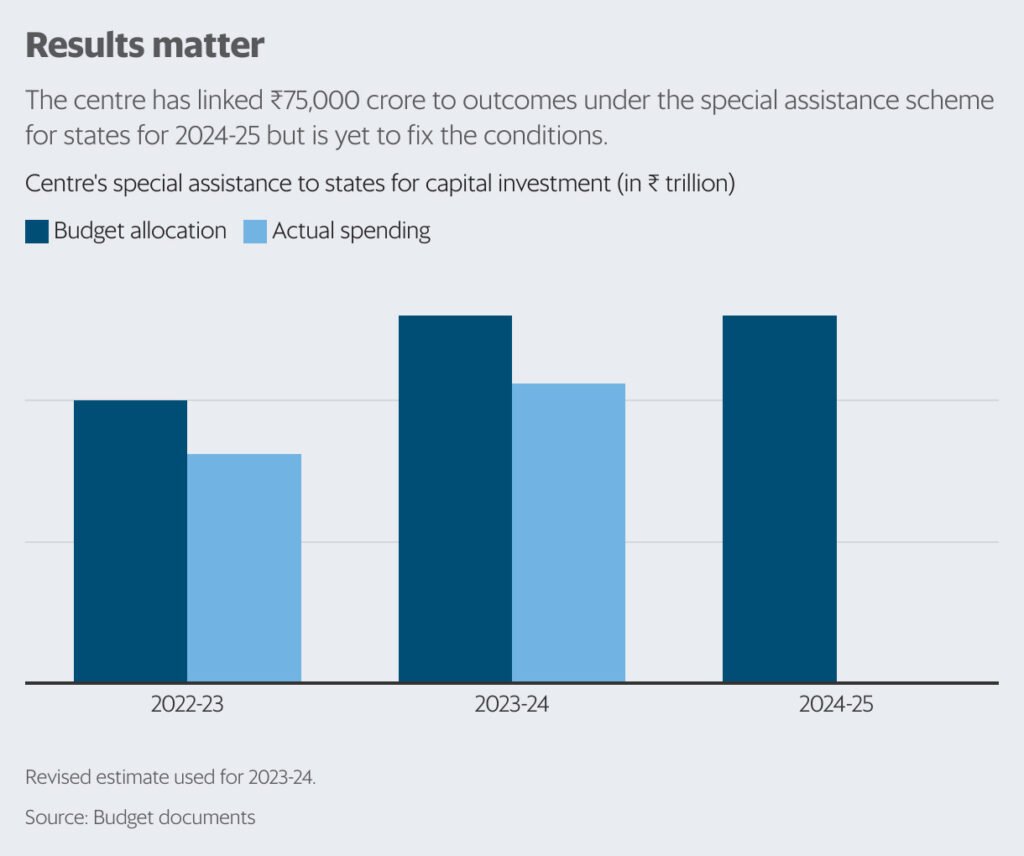₹75,000 crore of ₹1.3 trillion capital investment scheme tied to states’ outcomes and reforms, ensuring effective fund utilization.
Centre to States: Show Outcomes, Gain Interest-Free Capital Loans
In an effort to encourage timely capital investments in infrastructure, the Centre plans to allocate a substantial portion of the ₹1.3 trillion earmarked for the ‘special assistance to states for capital investment’ scheme in the interim budget 2024-25. This move involves linking around ₹75,000 crore, or 58% of the funds, to specific outcomes and reforms carried out by the states.
A Shift Towards Outcome-Based Funding
T.V. Somanathan, the Union finance secretary, revealed that the remaining ₹55,000 crore will also be subject to a “simple condition.” For states to access this interest-free loan, the allocated funds must be utilized for incremental infrastructure projects rather than substituting their existing capital expenditure.
Impact of Interest-Free Loans on Capital Spending
Notably, the provision of interest-free loans extended over a 50-year period has played a significant role in driving capital expenditures by the states and bolstering the economy post-pandemic. Given that states in India contribute 20–25% of the overall infrastructure spending, this scheme holds substantial importance for the government’s objectives.
Progression of the Scheme
The scheme, which was initially introduced in FY21 to aid states in the wake of the pandemic, witnessed an increase in allocation to ₹15,000 crore in FY22 and a significant surge to ₹1.07 trillion in FY23, with a noteworthy ₹27,000 crore linked to specific state-led reforms.
In the current fiscal year, the earmarked amount has escalated further to ₹1.3 trillion, with approximately ₹30,000 crore allocated based on outcomes. Moreover, states are expected to adhere to the condition that the loan should complement their capital expenditure and not serve as a substitute.
Challenges in Expenditure
Despite the ample budget allocations, actual spending by the states fell short of the proposed figures, indicating a divergence between budgeted and executed expenditures.
The alignment of funding with tangible outcomes signifies a strategic shift in the disbursement of capital investment assistance. As the government seeks to incentivize states to pursue infrastructure development, the outcome-based approach is poised to drive substantial progress in capital spending and economic rejuvenation.

Centre’s Conditions for States to Avail Capex Loans in Fiscal Year 24
In the fiscal year 24, states were required to fulfill certain conditions to be eligible for central loans. These included implementing reforms in the housing sector, offering incentives for scrapping old government vehicles and ambulances, enacting urban planning and finance reforms, increasing housing availability for police personnel, and establishing libraries with digital infrastructure at panchayat and ward levels for children and young adults.
Terms and Conditions for Fiscal Year 25
As of now, the Centre has not finalized the terms and conditions for the fiscal year 25. According to Somanathan, the conditions for the upcoming fiscal year may not be identical to those of the previous year, and the specific reforms and conditions are yet to be determined.
Expectations for Projects in the Fiscal Year
For loans not linked to specific reforms, it is anticipated that they will be allocated to projects slated for completion within the fiscal year.
States Opting for the Loan Scheme in Fiscal Year 24
During fiscal year 24, a total of 16 states availed the loan scheme. These included Arunachal Pradesh, Bihar, Chhattisgarh, Goa, Gujarat, Haryana, Himachal Pradesh, Karnataka, Madhya Pradesh, Mizoram, Odisha, Rajasthan, Sikkim, Tamil Nadu, Telangana, and West Bengal.
Finance Minister’s Perspective
In an interview, Finance Minister Nirmala Sitharaman emphasized the importance of utilizing capex within 12 months for optimal project development. Despite the longer gestation periods of many capital expenditure projects, the condition was imposed to ensure that the allocated funds are expended within a year. The minister noted that effective results have been demonstrated in cases where capex was utilized within the specified timeframe.
By adhering to the requirements set by the Centre, states can access capex loans and contribute to the development and progress of crucial projects within their jurisdictions.











